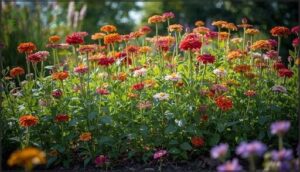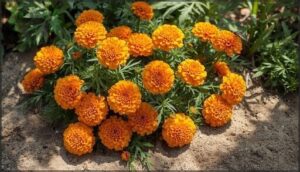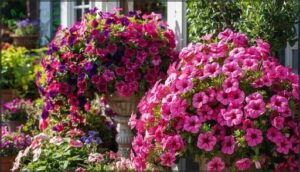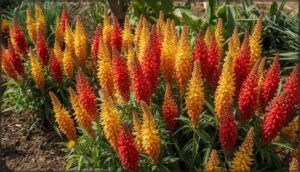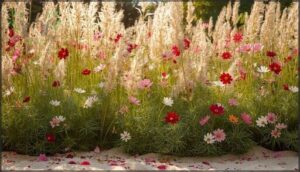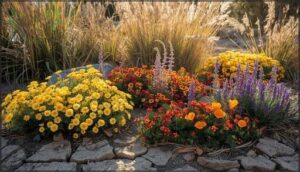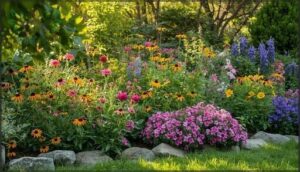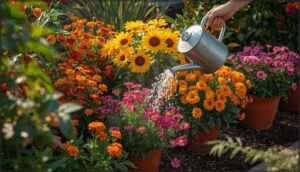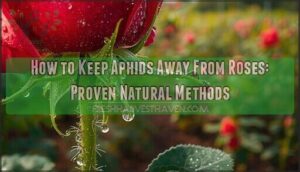This site is supported by our readers. We may earn a commission, at no cost to you, if you purchase through links.

The best part? Many come back year after year or reseed themselves, giving you more blooms for zero effort.
Whether you’re working with containers on a balcony, a patch of stubborn clay soil, or a full backyard begging for transformation, there’s a bulletproof summer flower that’ll work with your space and schedule.
Table Of Contents
- Key Takeaways
- Easiest Summer Flowers for Beginners
- Drought-Tolerant Summer Flower Options
- Shade-Loving Flowers for Cool Spots
- Perennials That Return Every Summer
- Top 10 Easy-Grow Flower Seeds for Summer
- 1. French Marigold Flower Seeds Mix
- 2. Carpet of Snow Alyssum Seeds
- 3. Catmint Seeds for Cats Planting
- 4. Tall Single Stem Sunflower Seeds
- 5. Zinnia Seeds Annual Flower Mix
- 6. Clear Impatiens Garden Flower Seeds
- 7. Begonia mix drought tolerant flower seeds
- 8. Tetra Mix Snapdragon Flower Seeds
- 9. Heavenly Blue Morning Glory Seeds
- 10. Sweet Pea Flower Seeds Mix
- Flower Care Tips for Summer Success
- Frequently Asked Questions (FAQs)
- Conclusion
Key Takeaways
- Drought-tolerant perennials like coneflowers, yarrow, and Russian sage deliver continuous blooms from midsummer through fall with almost zero maintenance once their root systems establish after the first season.
- Starting from seed with foolproof varieties like zinnias, marigolds, and cosmos gives you explosive color within 60-90 days—just direct sow in warm soil, water weekly, and watch them self-seed for next year’s garden.
- Matching plants to your actual conditions—full sun versus shade, dry versus moist soil—matters more than expensive fertilizers or complicated care routines for keeping summer flowers thriving.
- Deadheading spent blooms weekly on annuals and feeding every 3-4 weeks keeps continuous color pumping until frost, while strategic mid-season plant rotation fills gaps without replanting entire beds.
Easiest Summer Flowers for Beginners
If you’re new to gardening, summer’s your chance to start easy and see real results.
The flowers below don’t ask for much—just sun, some water, and patience. Each one brings color without the fuss, perfect for breaking ground without breaking a sweat.
Zinnias – Bold Color, Low Maintenance
If you want bold summer color without babysitting your garden, zinnias are your ticket to a riot of blooms from June straight through the first frost. These heat-resistant champions laugh at dry spells and keep pumping out nonstop blooms in every color you can imagine—from fiery reds to soft pastels.
Toss some seeds in sunny, well-draining soil, give them weekly drinks, and watch them explode into four-foot towers of easy-care summer color that’ll make your garden layout pop all season long.
Marigolds – Pest-Deterring and Hardy
While zinnias bring the wow-factor, marigolds are the workhorses that thrive in almost any soil—even poor, sandy stuff—while naturally keeping aphids, mosquitoes, and other garden pests at bay with their pungent foliage.
These easy-care champions deliver nonstop blooms in warm golds and oranges with barely any deadheading, making them perfect for low-maintenance flower arrangements and bold garden design without any fussy soil preparation.
Petunias – Vibrant and Prolific Bloomers
Petunias are the bold extroverts of the summer garden—they bloom nonstop in every color from deep purples to striped candy shades, asking for little more than regular sun and consistent water to keep the show going strong until frost.
These low maintenance flowers give you waves of summer blooms with minimal fussing, making them perfect for containers, hanging baskets, or bright garden designs.
Just give your petunias six hours of full sun and you’ll get reliable color all season—no complicated petunia care required for these easy care champions.
Celosia – Unique Texture and Minimal Care
Celosia brings something different to the table—flame-like blooms in electric reds, oranges, and yellows that look more like a sculptor’s work than your typical flower, and they thrive on heat with almost zero hand-holding required.
These drought-tolerant, easy-to-grow summer flowers laugh at neglect and keep pumping out summer blooms when others wilt:
- Crested and plumed celosia varieties add bold flower texture to garden design
- Minimal care needed—just full sun and warmth
- Low-maintenance flowers that tolerate dry spells beautifully
- Easy-care annuals perfect for hot, sunny spots
- Stunning as fresh cuts or dried arrangements
Cosmos – Self-Seeding Summer Blooms
Cosmos are those breezy, feathery-leaved plants that pop up on their own year after year once you’ve planted them once—they’re basically the gateway drug to a self-sustaining garden. These easy to grow summer flowers scatter seeds everywhere, filling sunny spots with daisy-like summer blooms in pink, white, and crimson without you lifting a finger.
Cosmos care is laughably simple: sandy soil, full sun, and you’re done—they’re perfect low-maintenance flowers for garden design or casual flower arrangements.
Drought-Tolerant Summer Flower Options
If your garden is parched more often than it’s watered, you’re not stuck with brown dirt and wilted stems. There are plenty of summer flowers that actually prefer dry conditions and won’t give up on you during a heat wave.
Here are seven drought-tolerant options that’ll keep blooming even when the rain decides to skip town.
Coneflowers – Reliable Perennial Blooms
If you want a perennial that laughs in the face of summer heat and comes back stronger every year, coneflowers are your go-to choice. These perennial flowers manage blooming cycles like champs, producing daisy-like flowers from midsummer through fall with minimal perennial care.
They’re perfect for full sun in garden designs, thriving in drought conditions once established. You can start them through seed propagation or grab transplants—either way, these easy-to-grow summer flowers become low-maintenance rockstars that attract pollinators and work beautifully in flower arrangements.
Black-Eyed Susans – Heat and Drought Proof
Black-eyed Susans are summer’s tough-as-nails powerhouse, thriving through dry spells and scorching days while cranking out cheerful golden blooms that’ll brighten your garden from early summer straight through fall.
These heat-resistant flowers tolerate part shade or full sun, making them wildflower care superstars that spread readily and attract pollinators without demanding constant attention.
- Drought tolerance kicks in after establishment—minimal watering needed
- Heat resistance means they bloom profusely when other flowers wilt
- Garden hardy perennials return year after year with zero fuss
- Perfect for low-maintenance flowers in naturalized or cottage-style gardens
Yarrow – Sun-Loving, Colorful Clusters
Yarrow thrives where other flowers give up—it loves full sun, poor soil, and hot conditions, producing flat-topped clusters of blooms in shades of yellow, pink, red, and white all summer long without asking for much in return.
This drought-tolerant perennial manages neglect like a champ, making yarrow care basically hands-off once established.
Those colorful blooms work beautifully in garden design as cut flowers or border fillers, attracting pollinators while you kick back and enjoy the show.
Gaillardia (Blanket Flower) – Fiery Color, Easy Care
Gaillardia lights up summer gardens like a bonfire that never burns out—those red, orange, and gold daisy-like flowers bloom from early summer straight through fall with almost zero fussing required.
Blanket flower tolerates drought, heat, and poor soil like a champ, making gaillardia care basically foolproof for beginners or anyone who wants fiery blooms without the work.
- Full sun flowers that thrive in dry conditions where other plants struggle
- Low maintenance flowers that attract pollinators all season long
- Summer color that keeps coming back year after year with minimal deadheading
Globe Amaranth – Long-Lasting Drought Tolerance
Globe amaranth grows like a tiny firework garden—those papery, clover-shaped blooms in hot pink, purple, white, and red stay vivid from summer until the first hard frost, and they laugh in the face of drought once their roots take hold.
These drought-tolerant flowers only need occasional watering after establishment, making amaranth care ridiculously simple for water conservation. Globe amaranth thrives in average soil and full sun, delivering long-lasting blooms that make them perfect low-maintenance flowers for hot, dry spots where other summer flowers tap out.
Catmint – Low-Maintenance and Hardy
Catmint is the kind of drought-tolerant perennial that practically raises itself—once it survives its first season, it prefers you leave it alone, rewarding your neglect with clouds of lavender-blue blooms and silvery foliage that pollinators can’t resist.
- Catmint care becomes simple after year one—drought tolerance kicks in hard, and these hardy perennials thrive with a hands-off approach
- Low maintenance garden design gets a serious boost from catmint’s flower longevity, blooming from late spring through fall with zero fuss
- These easy care plants tolerate poor soil, deer, and heat, making them bulletproof drought tolerant plants for rough spots
- Cut back once mid-season for a fresh flush—that’s your entire maintenance routine for these lowmaintenance flowers
Purple-Top Verbena – Happy in Dry Soil
Purple-top verbena is your ticket to filling hot, dry corners with airy purple flowers that laugh off drought and actually prefer you skip the fussing—perennial in Zones 7-11, it colonizes lean soil like it’s on a mission.
Drought tolerant plants don’t get more forgiving: verbena varieties thrive in full sun with minimal water, making them ideal easy to grow plants for perennial ground cover where soil conditions run bone-dry and unforgiving.
Shade-Loving Flowers for Cool Spots
Not every garden basks in full sun, and that’s where shade-loving flowers come in. These varieties brighten up dim corners, shaded borders, and spots under trees without needing direct sunlight.
Here are seven reliable options that’ll keep your cool spots colorful all summer long.
Impatiens – Nonstop Shade Blooms
If you’ve got a shady corner that feels more forgotten than fabulous, impatiens are your ticket to transforming it into a riot of color without breaking a sweat. These shade blooms thrive where sun lovers struggle, pumping out flowers nonstop from spring through frost with barely any fuss.
Just keep the soil moist and watch your shade garden come alive—perfect for low-maintenance gardening and summer garden ideas that actually deliver.
Torenia – Humid Shade Specialist
When your shady spots also run on the muggy side, torenia steps up where other flowers might sulk. These trumpet-shaped beauties tolerate humid climate conditions like champs, pumping out summer blooms in purple, pink, and yellow without the drama.
Perfect for shade gardening in sticky weather, they’re heat-resistant flowers that keep your low-maintenance gardening goals on track while adding flower texture most easy garden flowers can’t match.
Begonias – Versatile and Easy
Begonias don’t care whether you plant them in sun or shade—they’ll bloom either way, which makes them the flexible friend every gardener needs. Available in rose, orange, and plenty more hues, they’re perfect for potting mix experiments or garden designs where you’re still figuring things out.
Begonia care stays simple—water when dry, and they’ll keep pumping out summer blooming flowers for your beds or flower arrangements without fuss.
Sweet Alyssum – Soft Carpets for Shade
Sweet alyssum spills into every forgotten corner like a fragrant white or purple blanket, making peace with shade where other bloomers throw in the towel. This ground cover laughs at low maintenance gardening rules:
- Tolerates shade garden spots AND full sun locations
- Forms carpet flowers without constant attention
- Self-seeds for next year’s white blooms
Alyssum care stays minimal—water occasionally, and you’ve got yourself easy to grow flower gardening gold.
Astilbe – Feathery Plumes for Partial Shade
Astilbe sends up feathery plumes in shades of pink, red, and white like tiny fireworks exploding in slow motion across your shaded beds. This perennial flower thrives in partial shade and partial sun, making it perfect for shade gardens where most bloomers bail.
You’ll get low-maintenance gardening and outstanding flower arrangements without breaking a sweat—astilbe’s feathery plumes add serious punch to any garden design while asking almost nothing in return.
Hosta – Summer Spikes and Foliage Interest
Hosta delivers graceful spikes of lavender or white blooms that pull hummingbirds right into your shaded garden like magnets. But the real show is the foliage—leaf colors range from chartreuse to deep blue-green, giving you year-round interest in shade gardens where most perennial flowers struggle.
Hosta care is dead simple: plant once, forget about it, and watch it multiply into lush clumps without the fuss of full sun flower gardening or drought tolerant flower options.
Heuchera – Delicate Bell-Shaped Flowers
Heuchera throws up stalks of tiny pink or white bell-shaped flowers from early to midsummer—delicate blooms that hover like fairy lights above foliage so colorful it rivals the flowers themselves. Heuchera care is laughably easy in shade plants territory:
- Plant once in partial shade and watch low maintenance flower gardening take over—no full sun flower gardening stress here
- Drought tolerant flower options once established, shrugging off dry spells better than most perennial flowers
- Leaf colors span burgundy to lime, giving perennial gardens texture that outlasts any bell flower show
- Zero fuss maintenance—just trim spent flower stalks and let Heuchera do its thing
Perennials That Return Every Summer
If you want flowers that stick around year after year without replanting, perennials are your best bet. They go dormant when the weather cools, then come back strong each spring with minimal effort on your part.
Let’s look at some tried-and-true perennials that make summer gardening a breeze.
What Are Perennial Plants?
Perennials are plants that grow back year after year from the same root system—think of them as your garden’s reliable comeback crew. Unlike annuals that live fast and die after one season, perennial flowers go dormant each winter and reemerge when conditions warm up.
This root development makes perennial gardening a low-maintenance flower gardening approach since you plant once and enjoy for years. Perennial benefits include stronger root systems, less replanting work, and smarter garden planning for long-term success.
By understanding the soil improvement benefits, gardeners can make informed decisions about their perennial gardens.
Are Perennials Hard to Grow?
Most perennials aren’t hard to grow once you understand their growth patterns—they just need patience. Following the “sleep, creep, leap” rule, year one focuses on root establishment with minimal blooms. By year three, your low-maintenance plants hit their stride with abundant flowers and stronger resilience.
Success depends on matching perennial plants to your soil requirements and environmental factors. Easy-to-grow varieties like coreopsis establish fast, while others need time.
Smart garden planning and basic perennial flower care—occasional deadheading, dividing overcrowded clumps—keep perennial gardening simple and rewarding for years. Understanding good soil preparation is also essential for the health and longevity of your plants.
Do Perennials Grow Anywhere?
Not every perennial plant will thrive everywhere—climate tolerance and regional limitations matter. Perennials dominate about 94% of plant species globally, but tropical types fail in frost zones, while cold-hardy varieties struggle in hot, dry climates. Your USDA hardiness zone guides perennial adaptation, though soil requirements and altitude effects play big roles too.
Well-drained soil and proper site selection beat fighting your environment. Match low-maintenance plants and drought-tolerant gardens to your local conditions for easier perennial flower care.
Phlox – Reliable Summer Blooms
Phlox delivers a bounty of summer blooms without demanding much from you—perfect for those who want color without the fuss. Garden phlox produces fragrant flowers in pink, white, and purple shades across many varieties, making them naturals for flower arrangements.
They’re easy to grow once established, thriving in full sun with basic summer garden care. This perennial gardening staple manages perennial flower gardening with minimal intervention—just give them decent drainage and watch summer blooms take over.
Shasta Daisy – Classic White Flowers
Shasta daisies bring that fresh, classic look with white petals and sunny yellow centers on tall, sturdy stems—the kind of straightforward perennial that just works. They’re built for full sun and well-drained soil, thriving in summer perennials setups without babying.
Why Shasta daisy care is so easy:
- Adapt to most garden designs with their classic white blooms
- Grow reliably as perennial flowers that return year after year
- Produce loads of stems perfect for flower arrangements
- Tolerate heat and need minimal fussing once established
- Easy to grow for beginners chasing dependable color
Russian Sage – Fragrant, Long-Blooming
Russian sage knows how to make an entrance—those silvery spikes of lavender-blue flowers bring fragrance and serious staying power from midsummer straight through early fall. This heat-resistant, drought-tolerant beast thrives on neglect, making perennial care laughably simple once it’s established.
| Feature | Russian Sage |
|---|---|
| Bloom Period | Midsummer through early fall |
| Water Needs | Drought resistance after establishment |
| Care Level | Low-maintenance plants territory |
Fragrant blooms on tough, woody stems mean you get long-lasting color without the fuss—perfect for perennial plants lovers chasing freedom from garden chores.
Daylily – Easiest Showy Perennial
Daylilies laugh in the face of every rookie mistake—forget to water them, plant them in less-than-perfect soil, and they’ll still deliver knockout blooms like you knew what you were doing all along.
Daylilies thrive despite neglect, delivering stunning blooms even when you forget to water or plant them in poor soil
With thousands of daylily varieties in blooming seasons spanning weeks, these low-maintenance plants fuel flower arrangements and garden design schemes without demanding your soul.
Plant once, watch perennial plants multiply—total freedom.
Top 10 Easy-Grow Flower Seeds for Summer
Starting a garden from seed is easier than you’d think—and nothing beats the satisfaction of watching blooms emerge from a packet you planted yourself.
These ten seed varieties are practically foolproof, thriving in summer heat with minimal fuss.
Whether you’re tossing seeds into beds or containers, you’ll find options here that work for your space and schedule.
1. French Marigold Flower Seeds Mix
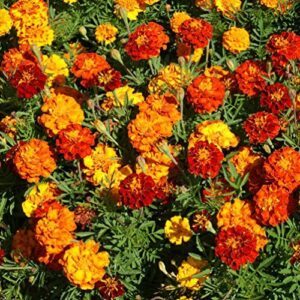
French marigold seeds are a solid starting point for beginners diving into annual flowers—these compact bloomers pack vibrant yellows, golds, oranges, and reds into 6–12 inch plants that won’t sprawl out of control. Seed germination happens fast, usually within 5–10 days at around 70°F, and you’ll see flowers in 63–77 days.
Marigold care is refreshingly simple: they tolerate a range of soils, withstand drought once established, and thrive in full sun across USDA Zones 1–12. The French Mix varieties offer double blooms perfect for flower arrangements or edging your flower garden.
As a bonus gardening tip for beginners, these easy-to-grow marigolds naturally repel whiteflies and other pests when planted near tomatoes—practical beauty with built-in garden protection.
Best For: Beginner gardeners looking for low-maintenance, pest-repelling annual flowers that deliver vibrant blooms throughout the summer and attract pollinators.
- Fast germination (5–10 days) and quick blooms (63–77 days) make results nearly instant for new gardeners
- Natural pest control benefits—repels whiteflies, nematodes, and aphids when planted near tomatoes or vegetables
- Thrives across USDA Zones 1–12 with minimal fuss, tolerating various soils and drought once established
- Requires consistent watering during germination and dry spells—not truly drought-proof despite claims
- Actual seed count and germination rates may fall short of the advertised 1,000 seeds
- Needs well-drained soil with specific pH (5.6–6.5) for best performance, which may require soil amendments
2. Carpet of Snow Alyssum Seeds
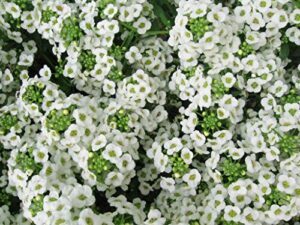
If you want a flower that acts like fresh white snow dusting your garden borders, Lobularia maritima delivers exactly that—and it’s ridiculously forgiving for newcomers.
Seed germination kicks off quickly with 60,000 tiny seeds that form low, spreading masses of fragrant summer blooms throughout the season.
Alyssum care is minimal: full sun, light watering (avoid drowning those seeds), and they’ll self-seed for next year’s flower garden.
These annual flowers work beautifully in flower arrangements or as low-maintenance plants edging your beds, plus their honey-like scent attracts pollinators—practical garden decor that actually does the work for you.
Best For: Beginner gardeners wanting a low-maintenance, fragrant ground cover that blooms all summer and attracts pollinators to their flower or vegetable beds.
- Quick germination with 60,000 seeds that spread into masses of fragrant white blooms throughout the season
- Minimal care needed—just full sun and light watering, plus they self-seed for the following year
- Sweet honey-like scent attracts pollinators while working as practical border edging for any garden
- Seeds can wash away or fail to germinate if soil is too compacted or watering is too heavy
- May need overseeding to achieve a thick, full carpet look initially
- Some users report inconsistent seed packaging quality and germination issues
3. Catmint Seeds for Cats Planting
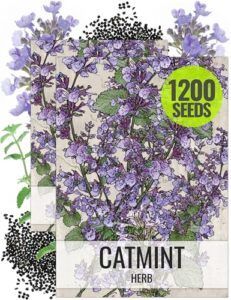
Think your cats will love you forever? Drop a few catmint seeds in your flower garden and watch the magic happen—about 70–80% of cats go wild for nepetalactone, the compound behind those euphoric head bumps and purrs.
This perennial plant thrives in full sun with well-drained soil and hits 12–24 inches tall, making it perfect for gardening for beginners chasing easy-to-grow options. Catmint benefits extend beyond feline attraction: it repels mosquitoes naturally and aids herbal uses like calming tea.
Follow basic cat planting tips—sow seeds uncovered, thin to 12–18 inches—and you’ll enjoy drought-tolerant summer blooms with zero fuss in your flower garden care routine.
Best For: Cat owners who want an easy-to-grow perennial that entertains their feline friends while adding drought-tolerant, pollinator-friendly blooms to their garden.
- Attracts 70–80% of cats with nepetalactone, creating natural enrichment and stress relief for your pets
- Thrives with minimal care in full sun and well-drained soil, plus it’s drought-tolerant once established
- Doubles as a natural mosquito repellent and attracts bees, making it functional beyond feline entertainment
- Not all cats respond to catmint, so about 20–30% may show zero interest in your plants
- Spreads aggressively and may require containment or regular division to prevent garden takeover
- Seeds need specific conditions (uncovered sowing, 65–70°F) and 7–14 days to germinate, requiring patience upfront
4. Tall Single Stem Sunflower Seeds
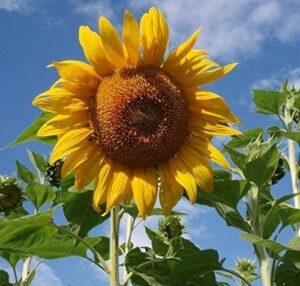
Standing at 8–12 feet with flower heads spanning up to 24 inches, these sunflowers are showstoppers built for drama.
Your tall single stem sunflower seeds need full sun and well-drained soil to hit their peak—plant them 1/2 inch deep when soil temps reach 70–78°F, and watch seed germination kick in within 5–12 days.
These annual flower gardening heroes thrive with moderate watering and deliver one massive bloom per plant—perfect for flower arrangements or attracting songbirds.
Space them 4–6 inches apart for cut stems, and follow easy-to-grow gardening tips like staking tall varieties against wind to prevent toppling.
Best For: Gardeners who want a dramatic vertical statement piece that attracts wildlife and produces massive single blooms for cutting or bird feeding.
- Massive flower heads (12–24 inches) on towering 8–12 foot stems create stunning visual impact and attract pollinators and songbirds
- Low-maintenance growth with non-GMO seeds that germinate in 5–12 days and reach maturity in 90–110 days
- Hand-packed in the USA with straightforward planting—just 1/2 inch deep in full sun with moderate watering
- 70% germination rate falls short of the 85% industry standard, meaning some seeds may not sprout
- Tall plants need staking in windy areas to prevent toppling, adding extra work mid-season
- Single bloom per plant limits flower production compared to branching varieties that yield multiple cuts
5. Zinnia Seeds Annual Flower Mix
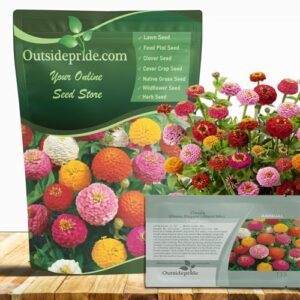
If you want bombproof annuals that bloom nonstop with barely any fuss, zinnia seeds are your ticket to garden freedom.
These easy-to-grow champions germinate in just 3–10 days when soil hits 70°F, and they’ll give you full blooms 60–90 days after sowing—perfect for garden beginners chasing instant gratification.
Zinnia care is ridiculously simple: toss seeds in full sun, space them 12 inches apart, and they’ll tolerate dry spells like champs while pumping out fresh flower arrangements all summer. Their blooming periods stretch from mid-summer to frost, attracting butterflies and hummingbirds at rates that leave other annuals in the dust.
For annual flower gardening with maximum payoff and minimal headaches, zinnias deliver bold color and pollinator power without the drama.
Best For: Beginner gardeners and busy homeowners who want a vibrant, low-maintenance pollinator garden with months of continuous blooms and minimal effort.
- Fast germination (3-10 days) and quick blooms (60-90 days) mean you’ll see results fast, plus they attract butterflies, bees, and hummingbirds like crazy with some of the highest pollinator visitation rates among annuals.
- Incredibly easy to grow with minimal fussing—they tolerate dry soil, adapt to all US hardiness zones, and keep pumping out fresh flowers all summer until frost if you deadhead them.
- Great value with 1,000 non-GMO seeds that work perfectly for cutting gardens, containers, or large landscapes, giving you endless bouquets without buying more plants.
- Disease susceptibility kicks in after about 10 weeks, especially powdery mildew in humid conditions, and most varieties won’t look great for a full season without proper spacing and care.
- Can be finicky about transplanting and sensitive to extreme weather—heavy rain or wind might require staking for taller varieties, and they don’t handle frost at all.
- Some gardeners report smaller blooms than expected, and they’re strictly outdoor plants since growing them indoors makes them leggy and high-maintenance.
6. Clear Impatiens Garden Flower Seeds
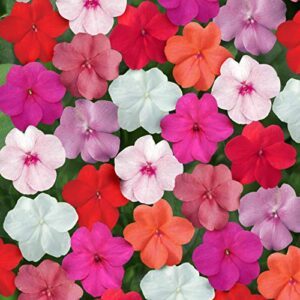
For shade gardens craving low-fuss color, clear impatiens garden flower seeds deliver nonstop blooms from mid-summer through frost with minimal babysitting.
These shade-loving rebels germinate in 3–10 days at 72–76°F—just press seeds onto moist soil without covering them, since light triggers seed germination.
Impatiens care is straightforward: plant in well-drained soil rich in organic matter, space 10–12 inches apart, and water when the top inch dries out.
They thrive in partial to full sun (though they prefer shade), making them perfect for garden design in tricky spots where most flower gardens fail. Their pollinator-friendly blooms increase 400% in shaded conditions, turning challenging corners into vibrant flower arrangements without the drama.
Best For: Gardeners looking for reliable, colorful blooms in shady spots where most flowers struggle, without spending hours on maintenance.
- Fast germination in 3–10 days with straightforward planting—just press seeds onto moist soil and let light do the work, no covering needed.
- Thrives in challenging shade conditions where other flowers fail, with pollinator visits increasing 400% in shaded areas due to prolific blooming.
- Delivers continuous color from mid-summer through frost with minimal care—just water when the top inch of soil dries out and apply monthly fertilizer.
- Germination rates can be inconsistent, ranging from 50% to 90%, meaning you might need to plant extra seeds to get your desired coverage.
- Requires precise soil temperatures (72–76°F) for germination and won’t tolerate frost, limiting your planting window to after the last frost date.
- Some customers report receiving fewer seeds than the advertised 100-count, and the seeds need careful moisture management to prevent rot or drying out.
7. Begonia mix drought tolerant flower seeds
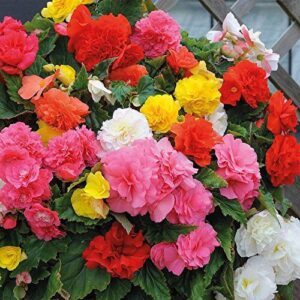
These begonias laugh off heat and dryness thanks to begonia care science: newer wax-leaf varieties build thicker cuticles under stress, boosting survival rates when water’s scarce.
Seed germination happens at 70–75°F with bright indirect light—no covering needed—and seedlings establish fast in well-drained soil.
Space tubers 1 foot apart, water moderately (early mornings prevent fungal drama), and watch them bloom in rose, orange, pink, and white all summer.
Drought tolerance meets low-maintenance gardening without sacrificing color or charm.
Best For: Gardeners in hot climates who want colorful, low-maintenance blooms that handle heat and infrequent watering without constant fussing.
- Heat and drought-tolerant varieties with thicker leaf cuticles survive dry spells better than standard begonias
- Blooms in multiple colors (rose, orange, pink, white) from spring through summer with minimal care
- Works well in shade or partial shade where other flowering plants struggle
- Seeds are extremely small and tricky to handle during planting
- Some customers report seeds don’t germinate or don’t match begonia characteristics
- Package lacks clear growing instructions or variety information
8. Tetra Mix Snapdragon Flower Seeds
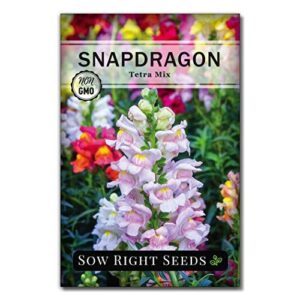
Ruffled snapdragon blooms in pink, purple, red, yellow, and white pack serious garden punch—and Tetra Mix makes snapdragon care genuinely beginner-friendly. These semi-dwarf snapdragons grow 1–2 feet tall, attract pollinators like crazy, and deliver stunning flower arrangements with thick, showy petals that enhance any garden designs—perfect easy-to-grow picks for gardening beginners seeking bold, low-fuss color.
Press seeds lightly onto moist soil at 64–70°F for seed germination in 7–14 days; they need light to sprout, so don’t bury them. Space plants 10–12 inches apart in full sun, water deeply every week, and deadhead spent flowers to stretch blooming periods from summer into fall.
Best For: Gardeners wanting large, colorful blooms with minimal effort—especially beginners who love cut flowers and attracting pollinators to sunny garden beds.
- Produces big, ruffled flowers in five vibrant colors (pink, purple, red, yellow, white) that attract butterflies and bees while making gorgeous cut arrangements
- Super easy germination and care—just press seeds onto soil, water weekly, and deadhead spent blooms for continuous summer-to-fall flowering
- Reseeds naturally each season and thrives in difficult soils, making it perfect for filling large garden areas with low-maintenance color
- Delicate stems fall over easily in windy spots, often requiring stakes or support structures to keep plants upright
- Some customers report germination failures or receiving wrong seed varieties, suggesting quality control inconsistencies
- Needs full sun (6 hours daily) and careful spacing to prevent overcrowding—won’t perform well in shady areas or cramped conditions
9. Heavenly Blue Morning Glory Seeds
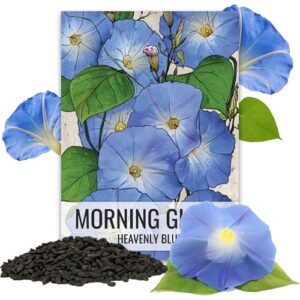
Climbers with serious wow-factor don’t get easier than Morning Glory vines—and Heavenly Blue delivers sky-blue trumpets with white centers from summer to fall. These heirloom vines shoot up 10–15 feet in one season, smothering trellises, fences, or arbors with vibrant Garden Decor that demands zero fuss.
Nick seeds with a file, soak overnight, then press into warm soil for Seed Germination in 5–10 days. Provide sturdy Vine Support, full sun, and weekly water—Morning Glories manage heat, reward minimal Plant Care, and self-seed like champs, making them premier Easy to Grow picks for Gardening for Beginners Guide projects.
Best For: Beginner gardeners wanting fast-growing, low-maintenance climbing vines that create dramatic vertical displays with vibrant blue blooms all summer long.
- Rockets up to 15 feet in a single season with minimal care—just plant, provide support, and water weekly
- Stunning sky-blue flowers with white centers bloom continuously from summer through fall, creating eye-catching displays
- Self-seeds for future years and thrives in heat with little fussing, making it perfect for hands-off gardeners
- Needs sturdy trellises or fences for support, and vines can become tangled or create tripping hazards without proper management
- Some users report inconsistent results with flower color or size not matching expectations
- Seeds require prep work (nicking and overnight soaking) before planting for best germination rates
10. Sweet Pea Flower Seeds Mix
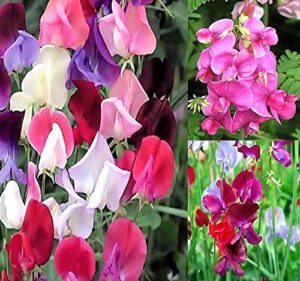
Heirloom Sweet Peas pack nostalgic charm into every fragrant, ruffled bloom—and this mix delivers Red, Salmon, Pink, and Lavender tones from mid-season plantings without fuss.
Growing 1–2 feet tall on upright stems, Sweet Peas thrive in full sun and almost any soil, making Seed Germination quick when you sow directly after frost. Provide moderate watering and mesh support for climbing varieties, then watch Easy to Grow Sweet Peas explode into colorful Flower Arrangements and Garden Designs.
With proper Sweet Pea Care during their Blooming Periods, beginners score fragrant, cut-friendly blossoms all summer—essential Plant Care intel for any Gardening for Beginners Guide, plus solid Flower Care Tips for continuous color.
Best For: Beginner gardeners who want easy-to-grow, fragrant flowers in full sun with minimal fuss and a colorful vintage look.
- Fragrant heirloom blooms in multiple colors (Red, Salmon, Pink, Lavender) perfect for cutting and arrangements
- Thrives in almost any soil type with just moderate watering and full sun exposure
- Quick germination and straightforward growth makes them ideal for new gardeners
- Germination rates can be inconsistent based on customer feedback
- Requires mesh or support structure for climbing, adding setup time
- Seeds may not reliably save for replanting in future seasons
Flower Care Tips for Summer Success
Growing stunning summer flowers doesn’t have to be complicated if you nail a few basics. The right care approach can turn even challenging gardens into thriving color zones all season long.
Here’s what you need to know to keep your blooms looking their best from planting through the first frost.
Watering and Drought Management
You don’t need to water every flower the same way—some are desert warriors, while others turn crispy without consistent moisture. Check soil moisture before watering—stick your finger two inches down.
Drought tolerant gardens with heat-resistant picks like yarrow and gaillardia need way less babying than impatiens. Well-draining soil prevents root rot, while drought planning and water conservation through rainwater harvesting keep your blooms thriving without cranking up the water bill.
Sun, Soil, and Location Choices
Most flowers won’t forgive you for sticking them in the wrong spot—full sun bloomers will sulk in shade, and shade lovers will literally fry under blazing afternoon rays. Match your sunlight requirements to what you’ve actually got:
- Full sun: 6+ hours for heat resistant picks like zinnias
- Partial shade: 3-6 hours for adaptable begonias
- Well draining soil: Sandy loam beats clay for drought tolerant plants
- Climate zones: Check hardiness before planting perennials
Soil quality and drainage systems matter more than fancy fertilizers for a low maintenance garden design.
Deadheading and Maintenance Basics
Snipping off spent blooms—what gardeners call deadheading—keeps your plants pumping out flowers instead of wasting energy on seed production. For heat-resistant annuals like zinnias and marigolds, you’ll barely need pruning techniques beyond a quick pinch every week.
Toss in some soil conditioning with compost, stick to watering schedules that match your climate, and go easy on fertilizer applications—most summer bloomers don’t need pampering to thrive.
Pest-Resistant and Pollinator-Friendly Options
Marigolds and blanketflowers double as bodyguards for your garden—naturally repelling aphids, whiteflies, and nematodes without a single spray. Pair them with bee-friendly plants like coneflowers and yarrow to build pollinator gardens that welcome butterflies and native bees while cutting pest problems by nearly 30%.
Sustainable landscaping wins when you mix deer-resistant perennials with low-maintenance annuals, creating flower diversity that fosters natural pest control methods year after year.
Best Flowers for Container Gardens
Container gardens pack all the color and fragrance of a full garden bed into compact spaces—perfect for balconies, patios, or front porches where ground planting isn’t an option. Choose low-maintenance plants like petunias and marigolds that thrive in garden pots with quality container soil—aim for a mix that drains fast but holds moisture.
- Patio plants need drainage holes and regular watering since small spaces dry out faster than ground beds
- Butterfly friendly plants like zinnias and verbena double as living flower arrangements you can rearrange anytime
- Perennial plants in large containers survive winter in Zones 5–9, giving you container garden ideas that return yearly
Tips for Continuous Blooms All Season
Keeping your summer garden vibrant past July requires some knowledge, but the reward is continuous color until the first frost. Deadhead spent blooms weekly on heat-resistant flowers like zinnias and marigolds—this encourages the plant to produce more buds instead of setting seed. Rotate in fresh, easy-to-grow plants mid-season to fill gaps, and feed every 3–4 weeks with balanced fertilizer to fuel continuous blooms.
Smart flower rotation and attention to blooming schedules keep low-maintenance plants performing all summer—minimal effort, maximum reward.
| Pruning Techniques | Fertilizer Applications | Soil Conditioning |
|---|---|---|
| Pinch back leggy stems | Liquid feed every 3 weeks | Add compost monthly |
| Remove faded flowers | Slow-release granules | Mulch to retain water |
| Cut perennial plants back by ⅓ | Dilute to half strength | Amend with organic matter |
| Trim heat-resistant flowers lightly | Foliar spray for quick boost | Test pH mid-season |
Frequently Asked Questions (FAQs)
How often should I fertilize summer flowers?
Fertilizer schedules depend on your soil testing results and the growth stages of your plants.
Light feeders like cosmos need minimal nutrients, while heavy bloomers benefit from balanced flower feeding every two to three weeks during peak season.
Can I grow summer flowers from cuttings?
Propagation is a great workaround when you’re short on seed money or want more of what you’ve got. Yes, you can grow summer flowers from cuttings using stem propagation and root division techniques—perfect for cloning your favorites and mastering flower care and maintenance.
When should I start planting summer flowers?
Start by checking your garden planning and weather forecast around your last frost date—that’s your green light.
For most regions, late spring is perfect for seed selection and soil preparation, giving you a jump on beginner gardening with easy-to-grow plants.
How do I overwinter tender summer perennials?
Tender perennials like begonias or impatiens need serious winter protection and frost management to survive cold snaps. Dig them up before the first freeze, pot in well-draining soil, and move indoors to a bright spot.
Cold frames or greenhouse care works too, providing soil insulation and climate control for low-maintenance garden design success.
What mulch works best for summer flowerbeds?
Organic mulch like shredded bark or aged compost keeps soil health strong and beats back summer weeds without chemicals.
Mulch materials break down over time, feeding your flower bed while cutting garden maintenance in half—basically a two-for-one deal.
Conclusion
Did you know that gardens with continuous blooms can attract up to 40% more pollinators throughout the season? That’s the power of choosing easy-to-grow summer flowers that keep delivering without demanding constant attention.
You’ve got the list now—heat lovers, shade specialists, perennials that return like clockwork, and seeds that practically plant themselves. Pick what fits your space and style, toss them in the ground, and let them work their magic.
Your summer garden doesn’t need to be complicated to be stunning.
- https://www.parkseed.com/blogs/park-seed-blog/how-perennials-grow-what-s-the-3-year-rule
- https://millcreekgardens.com/perennial-flowers-environmental-problems/
- https://www.chicagobotanic.org/plantinfo/tips/maintaining_perennial_garden
- https://fieldreport.caes.uga.edu/publications/B1424/landscape-basics-success-with-herbaceous-perennials/
- https://pmc.ncbi.nlm.nih.gov/articles/PMC9372509/

